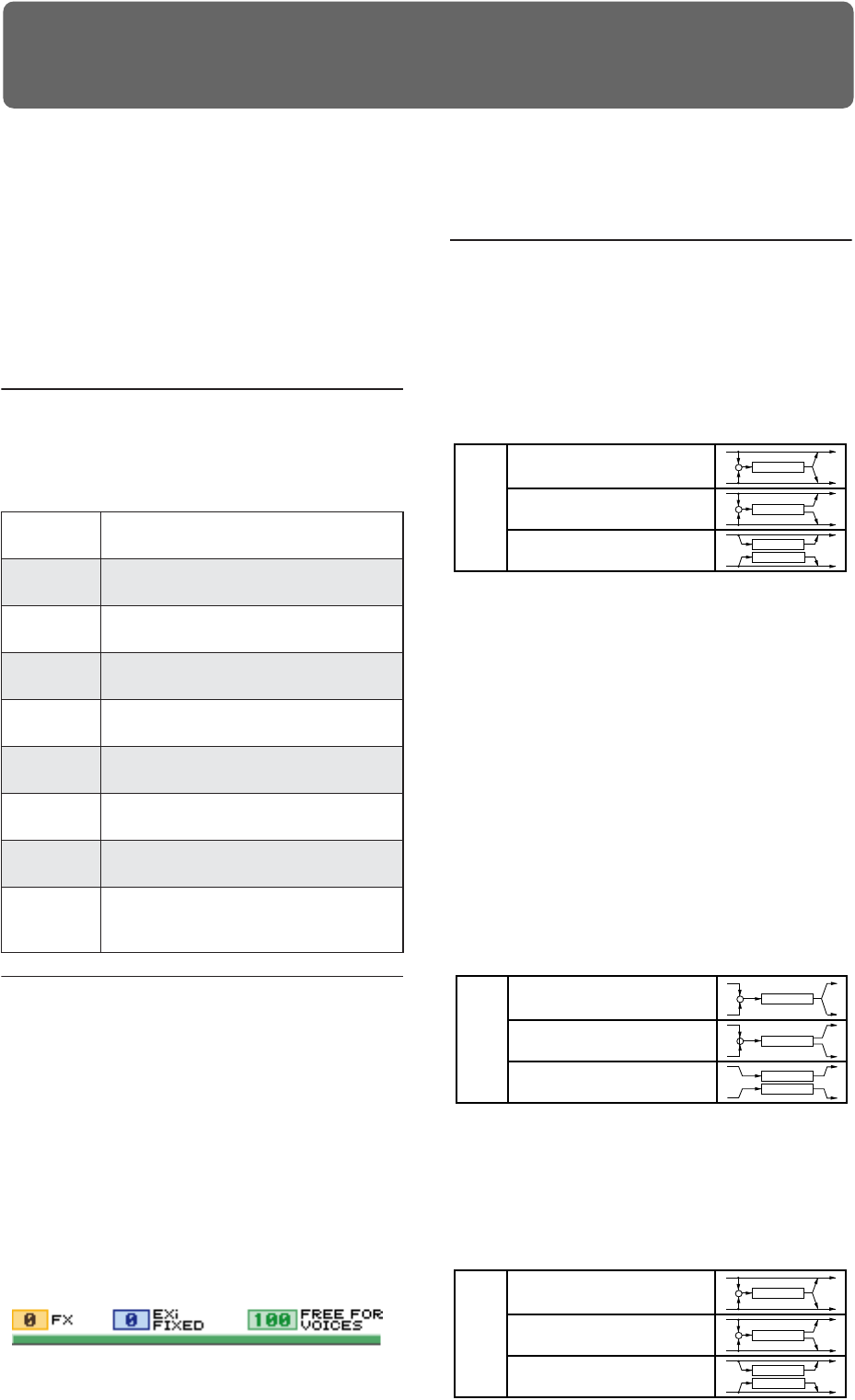
183
Using Effects
For effects processing, the OASYS provides 12 insert
effects, two master effects, and two total effects,
together with a mixer section that controls the routing
of these effects. All of these are stereo in/out.
Specific parameters of these effects can also be
controlled in real time from the OASYS’ controllers or
via MIDI messages using Dynamic Modulation
(Dmod), by MIDI/Tempo Sync, or by using a common
LFO to apply synchronized change to differing
modulation effects.
Effect types
You can choose from 185 different full-digital effects.
The effects are categorized as follows.
Classification of 185 effects
Maximum number of effects and
maximum voice polyphony
For each effect IFX1–12, MFX 1 and 2, and TFX 1 and 2,
you are free to choose and use any of 185 types of
effect. There is no limitation on the maximum number
or type of effects you can use.
However, a certain amount of digital processing
capability must be internally allocated in order to
produce each effect. The Effect/EXi Fixed Resource
Meter shows the amount of processing power
currently being used. You can find the meter on the
Track View tab of the P8: Insert Effect– Insert FX page,
and the Routing tab of the P9: Master/Total Effect
page.
Please note that power used by the effects will have an
impact on the available number of voices. For more
information, see “About polyphony” on page 33.
Effect I/O
Insert effects
Insert Effects (IFX 1–12) are stereo-in/stereo-out. If you
select Dry (unprocessed) for the Wet/Dry parameter,
the stereo input signal will be output in stereo without
being processed by the effect. If you select Wet (effect
applied), the processed signal will be output in one of
the following ways:
Master Effects
The I/Os of Master Effects MFX1 and MFX2 are stereo-
in/stereo-out. Send1 and Send2 determine the send
level to the Master Effects.
Master effects will not output the Dry (unprocessed)
signal specified in Wet/Dry. Only the Wet (processed)
signal will be output. The output signals from the
Master Effects are routed to the L/R bus with the
output level specified by Return1 and Return2. These
output signals are mixed with the output signals from
the bus specified by Bus Select (P8: “Routing” page in
each mode) L/R, or with the output signals from the
bus specified by Bus Select (“Insert FX” page in each
mode) L/R, then routed to the total effect.
Selecting “000: No Effect” will mute the output. The
processed signal will be output in one of the following
ways, according to the type of effects 001–185.
Total Effects
The total effects TFX1 and TFX2 are stereo-in/stereo-
out. The Dry (unprocessed) side of the Wet/Dry
parameter sends the stereo input sound directly to the
stereo output. The way in which the Wet (processed)
side is output depends on the type of effect, as follows.
Dynamics:
000…010
Effects which control volume, such as
compressors, limiter, and gates
EQ/Filter:
011…026
Effects which control frequency content, such
as EQ, multi-mode filter, exciter, and wah
OD/Amp/Mic:
027…039
Overdrive and amp modeling effects such as
guitar/bass amps and mics
Cho/Fln/Phs:
040…054
Pitch and phase modulation effects such as
chorus and flanger
Mod/P.Shift:
055…076
Other modulation effects such as tremolo and
rotary speaker, and pitch shifters
Delay:
077…099
Delays
Reverb/ER:
100…108
Reverb and early reflections
Mono-Mono:
109…140
Mono & Mono chain effects that internally
connect two mono effects in series
Mono/Mono:
141…185
Mono & Mono parallel effects that allow two
mono effects to be applied to L and R
independently
Stereo In - Stereo Out
Mono In - Mono Out
Mono In - Stereo Out
Effect
Effect
Effect
+
Effect
+
Wet
Stereo In - Stereo Out
Mono In - Mono Out
Mono In - Stereo Out
Effect
Effect
Effect
+
Effect
+
Wet
Stereo In - Stereo Out
Mono In - Mono Out
Mono In - Stereo Out
Effect
Effect
Effect
+
Effect
+
Wet


















